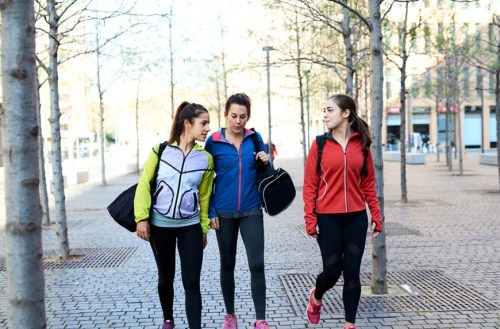Our editors independently select these products. Making a purchase through our links may earn Well+Good a commission
The gross reason you should stop putting your sweaty gym clothes in plastic bags
The odor is only one factor; sweaty clothes can harbor bacteria that can cause skin issues and infections. Here's what to do instead.

Must-haves at any good boutique studio or gym: deodorant, lots of dry shampoo, and plastic bags so you can stash your sweaty garb and go. That last one, though—you might want to reconsider.
Stuffing your wet clothes in a sack that holds in sweat is the worst thing you could do with them—whether you’re leaving them tucked away all day at the office or only for the half-hour it takes to go from gym to home—according to Kelly Reynolds, PhD, a microbiologist and associate professor at the University of Arizona’s College of Public Health. “Moisture and heat create the perfect conditions for bacteria and mold to grow,” she says. “In a short amount of time, you can grow lots of bacteria—some bacteria can double in concentration every 20 minutes.” Eeew!
The result: stinky, musty smells and mildew that no level of laundering will nix. But the funky odors are far from the only downside.

Germs on your gym clothes can also lead to health issues, the number one being skin problems—from rashes to serious staph infections. Of course, bacteria aren’t all created equal. Some carry a bigger health risk than others. Unfortunately some really nasty ones (see: MRSA) are often present in gym settings.
And even if you dump your duds in the laundry as soon as you get home, you could spread the germs to roommates or family members via the washing machine.
Instead of plastic, throw sweaty garments in a mesh bag for your commute.
Instead of plastic, you can always throw sweaty garments in a mesh bag for your commute; being exposed to air will let them dry sooner and sidestep some of the bacterial growth. Then when you get home, if you don’t want to do a load of laundry after every single class (and who does?), you can do the next best thing: Rinse your clothes in the sink ASAP and hang them to dry. “The faster you can dry the clothes, the better for reducing mold and bacterial growth,” says Reynolds.
When you do get to washing, use hot water to help kill off as many germs as possible. For fabrics and colors that can handle it, add bleach (or a healthy alternative like OxyClean) to the wash cycle, says Reynolds, as it’s the best way to sanitize your laundry. Toss them in the dryer on high heat, too (just steer clear of fabric softeners and dryer sheets, as they can leave a residue on performance fabrics that traps in odors).
There’s a very small window between when you peel drenched clothes from your body post-workout and when nasty bacteria might start multiplying, says Reynolds: “You’re really racing against the clock.” So go, go, go!
Speaking of gym threads, here’s a genius trick for storing your workout clothes. And don’t miss the best leggings as chosen by Well+Good readers!
Sign up for the Well+Good SHOP Newsletter
Get exclusive deals on wellness, beauty, fitness, and food products that have been hand-picked by our editors.
Got it, you've been added to our email list.







